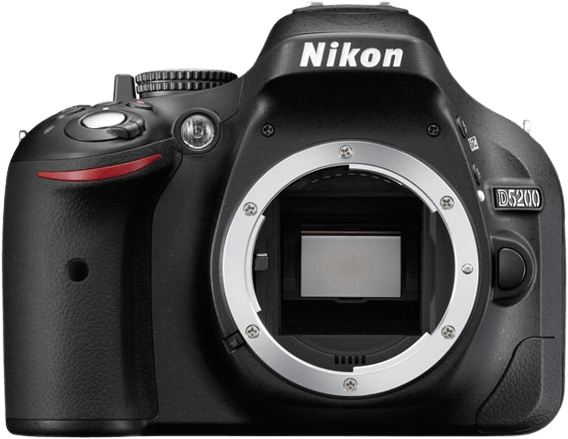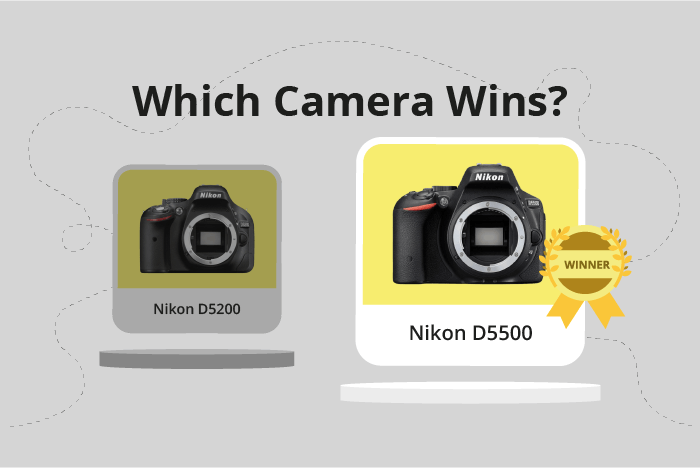Nikon D5200 vs D5500 Comparison
Nikon D5200

Nikon D5500

The Nikon D5500 triumphs over the Nikon D5200 with a score of 61/100, compared to the latter’s 56/100. Both cameras are DSLR models, announced in 2015 and 2012 respectively. They have similar launch prices, with the D5200 at $897 and the D5500 at $900.
The winning D5500 boasts a more compact size (124 x 97 x 70mm) and lighter weight (420g), making it a more portable option. On the other hand, the D5200 is slightly larger (129 x 98 x 78mm) and heavier (555g), which could be beneficial for users who prefer a more substantial camera body.
Taking these specifications into account, the Nikon D5500 emerges as the more convenient and modern camera choice, while the D5200 could still appeal to those who appreciate a heftier build.
Nikon D5200 vs D5500 Overview and Optics
When comparing the optics of the Nikon D5200 and the Nikon D5500, both cameras receive a score of 65/100. This means that there is no clear winner in this aspect, and both cameras perform similarly in terms of optics.
The Nikon D5200 and D5500 share several specifications, including a 24.1 and 24.2-megapixel resolution, respectively, a shooting speed of 5 frames per second, a CMOS sensor type, an APS-C sensor size, a Nikon F DX lens mount, and the absence of image stabilization. Additionally, both cameras have a DXOMARK score of 84 for their sensors, indicating that they have the same level of sensor performance.
The main difference between the two cameras is the processor, with the Nikon D5200 using an Expeed 3 processor and the D5500 using an Expeed 4 processor. The upgraded processor in the D5500 allows for better overall performance and faster image processing, which may give it a slight edge over the D5200 in certain situations.
However, the Nikon D5200 still holds its own in terms of optics performance, as it shares many of the same specifications as the D5500. This means that the D5200 remains a solid choice for photographers who prioritize optics quality.
Given their similar performance in optics, the decision between the Nikon D5200 and D5500 will likely come down to other factors, such as price, additional features, and personal preferences. Both cameras offer strong optics capabilities, making either one a suitable choice for photographers seeking high-quality images.
Nikon D5200 vs D5500 Video Performance
The Nikon D5200 and Nikon D5500 both score 70/100 in video capabilities, showing no clear winner between the two. These cameras share several specifications, making them quite similar when it comes to video performance.
Both the D5200 and D5500 have a maximum video resolution of Full HD with dimensions of 1920 x 1080 pixels. They also both offer a maximum video frame rate of 60fps, ensuring smooth motion in videos. Additionally, both cameras have built-in time-lapse functionality, allowing users to create stunning time-lapse videos without needing additional software or equipment.
Since the video scores and specifications are equal for both cameras, there is no clear winner in this category. Neither camera outperforms the other in terms of video capabilities. However, it is essential to consider other factors, such as price, size, and additional features when choosing between the two.
Although the Nikon D5200 and D5500 have identical video capabilities, users may find minor differences in other aspects, such as ergonomics, build quality, or autofocus performance. These factors might influence a user’s decision when selecting a camera. It is crucial to keep in mind that the video performance of both cameras is on par with each other, and users can expect similar results in this regard.
To conclude, the Nikon D5200 and D5500 are equal in terms of video capabilities, with both cameras offering Full HD resolution, 60fps frame rate, and built-in time-lapse functionality. Users should consider other factors such as price, size, and additional features when making their final decision.
Nikon D5200 vs D5500 Features and Benefits
The Nikon D5500 wins in the features comparison with a score of 59/100, while the Nikon D5200 has a lower score of 41/100. Both cameras have some common specifications, including a flip screen and no GPS functionality. Neither camera has Bluetooth capabilities.
The D5500 outperforms the D5200 in several aspects. It has a larger screen size of 3.2 inches compared to the D5200’s 3-inch screen. Additionally, the screen resolution of the D5500 is higher at 1,037,000 dots, while the D5200 has a resolution of 921,000 dots. The D5500 also features a touchscreen, making it more user-friendly and efficient to navigate. Furthermore, the D5500 has Wi-Fi connectivity, allowing for easy sharing and transfer of photos.
On the other hand, the D5200 does not have any significant advantages over the D5500. It lacks a touchscreen and Wi-Fi connectivity, which are both present in the D5500. The smaller screen size and lower resolution also make the D5200 less appealing in terms of features.
Considering the points mentioned above, it is clear that the Nikon D5500 is the better camera in terms of features. It offers a larger and higher-resolution touchscreen, as well as Wi-Fi connectivity. While the D5200 shares some common specifications with the D5500, it does not have any notable advantages. Therefore, the Nikon D5500 is the recommended choice for those seeking a camera with better features.
Nikon D5200 vs D5500 Storage and Battery
The Nikon D5500 outperforms the D5200 in the storage and battery category, scoring 35 points compared to the D5200’s 27 points. Both cameras share some storage specifications, such as having a single memory card slot and accepting SD, SDHC, and SDXC memory cards.
The D5500’s superiority is evident in its battery life, providing 820 shots per charge, while the D5200 offers only 500 shots. Both cameras use the EN-EL14 battery type and lack USB charging capabilities. The D5200 does not hold any advantages in this area over the D5500.
Considering these factors, the Nikon D5500 is the clear winner in terms of storage and battery performance. Its longer battery life makes it a more reliable choice for photographers who need extended shooting capabilities. The Nikon D5200, on the other hand, falls short in this category, making the D5500 a better option for those prioritizing battery life and storage.
Alternatives to the Nikon D5200 and D5500
Are you still undecided about which camera is right for you? Have a look at these popular comparisons that feature the Nikon D5200 or the Nikon D5500:

